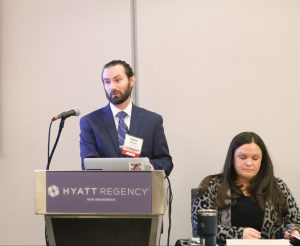Session Summary
If “timing is everything” like some people say, the 2020 Redevelopment Forum happened at an opportune time for those of us who dwell on stormwater. Engineers, planners, developers, landscape architects, attorneys and municipal officials all had good reason to hang on to the words of presenters at the Forum session titled Stormwater 2020: Smooth Sailing or Choppy Waters?
Four days before the Forum, the New Jersey Department of Environmental Protection (NJDEP) published long-awaited, important amendments to the state’s stormwater management rule (N.J.A.C. 7:8). The most notable change in the rule is a requirement that green infrastructure practices be used to meet the standards for water quality, quantity and recharge.

Gabriel Mahon, Bureau Chief, New Jersey Department of Environmental Protection.
The new “green infrastructure rule,” as it’s being called, takes full effect on March 2, 2021. It will fundamentally change the way stormwater is managed in new development projects, and very likely is a step toward further rule amendments that will apply the green infrastructure requirement to redevelopment and to smaller sites than currently are covered by the stormwater rules.
Also on the minds of many in the room: stormwater utilities—specifically, the what, why, who and how. And the “how much”? What exactly is a stormwater utility? Why would such a thing be important to my town and its taxpayers? Who needs to be at the table and how do they evaluate costs and benefits? And how much of a fee are we talking about?
The common denominator of stormwater rule changes and stormwater utilities is the need to more effectively manage stormwater in our age of climate change. NJDEP’s Climate Data show a nearly 10% rise in annual precipitation over the past 100 years, and Climate Central data show that New Jersey, like other northeastern states, is experiencing far more heavy rain events. Stormwater management is getting harder and more complicated; much existing “gray infrastructure” is old and undersized.
Enter our panel of experts to illuminate the path forward!
With Erin Law, Esq. of McManimon, Scotland & Baumann moderating, panelists provided a trove of information and detail to help listeners understand how the changing stormwater landscape will play out. A key theme was: those who embrace the changes and opportunities can reap real benefits.

Stormwater 2020: Smooth Sailing or Choppy Waters? session at the Redevelopment Forum. Panel: Louise Wilson, Erin Law, Eleni Giannikopoulos, Michele Adams, Tavis Dockwiller, and Gabriel Mahon.
NJDEP Bureau Chief Gabriel Mahon described the new stormwater rule requirements, certain key updates to the New Jersey stormwater Best Management Practices (BMP) Manual, and the implementation timeframe. Engineer Eleni Giannikopoulos of Suburban Consulting Engineers explained stormwater utilities, including their widespread use across the country, the mechanics of how to create a utility, how fees are commonly established and calculated, and what the fee revenue can pay for.
Among the most visible and beneficial manifestations of rule changes and utilities implementation will be green infrastructure installations in both public and private sector projects. Like all infrastructure, green infrastructure must be properly designed, constructed, monitored, and maintained.
Communicating effectively about it is also imperative, because ideally, people should know and appreciate what they’re looking at when they see a rain garden, a tree trench, a green roof, wet pond, or infiltration basin.
Engineer Michele Adams of Meliora Design and landscape architect Tavis Dockwiller of Viridian Landscape Studio delivered excellent advice in a tag-team presentation about green infrastructure, including practical problem-solving advice, lessons learned, and tips for success:
- Make sure homeowners with rain gardens understand “This is living infrastructure.”
- For high-functioning, low maintenance bioretention basins: “More grasses. Less mulch. Pops of color.”
- Engineered soil (for rain gardens and other bioretention practices) is not topsoil.
- People are often fearful of nature, so it’s important to include what Tavis called “societal reminders” — things like mown edges and fencing. These simple features deliver a reassuring message: “Someone is caring for this.”
One session cannot do justice to the scope and scale of New Jersey’s stormwater challenges. One uplifting takeaway from this Forum session, however, is that smart people are “on it.”
This summary was written by Louise Wilson from New Jersey Future.